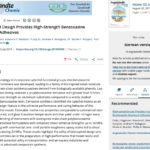New rules for access and benefit sharing (ABS) of genetic resources and associated traditional knowledge have been established by the Nagoya Protocol but have not kept up with rapid scientific and technological advances in biodiscovery. This suggests the need for innovative, transdisciplinary approaches to regulate ABS and emerging technologies.
Learn more (opens external site)
Scientists at Scripps Research have unveiled a new tissue-clearing method for rendering large biological samples transparent. The method makes it easier than ever for scientists to visualize and study healthy and disease-related biological processes occurring across multiple organ systems.
Described in a paper in Nature Methods on March 28, 2022, and […]
The bioengineering of cannabis
Genetic modification could enable industrial-scale production of cannabinoids that have pharmaceutical potential. Genetic engineering could provide more efficient alternatives. Some researchers and biotechnology companies are aspiring to replace cannabis plants with microorganisms that have been genetically enhanced to spit out THC, the non–psychoactive compound cannabidiol (CBD), and myriad other cannabinoids of pharmaceutical interest. Others are […]
The potential for using marine microbes for biodiscovery is severely limited by the lack of laboratory
cultures. It is a long-standing observation that standard microbiological techniques only isolate a very
small proportion of the wide diversity of microbes
that are […]
Fire ants survive floods by forming rafts made up of thousands of wriggling insects. A new study by engineers at CU Boulder lays out the simple physics-based rules that govern how these ant rafts morph over time: shrinking, expanding or growing long protrusions like an elephant’s trunk. Fire ants form these […]
A synthetic strategy to incorporate catechol functional groups into benzoxazine thermoset monomers was developed, leading to a family of bioinspired small-molecule resins and main-chain polybenzoxazines derived from biologically available phenols. Lap-shear adhesive testing revealed a polybenzoxazine derivative with greater than 5 times improved shear strength on aluminum substrates compared to a […]
FNs were first described as potent antiviral agents 40 years ago, and recombinant IFN-α2a and IFN-α2b were approved for the treatment of hairy cell leukemia just 11 years ago. Today, α-IFNs are approved worldwide for the treatment of a variety of malignancies and virologic diseases. Although the exact mechanism of action of IFN-α in the […]
Cellular pathways that repair chromosomal double-strand breaks (DSBs) have pivotal roles in cell growth, development and cancer. These DSB repair pathways have been the target of intensive investigation, but one pathway — alternative end joining (a-EJ) — has long resisted elucidation. In this Review, we highlight recent progress in our understanding of a-EJ, especially the […]
Lotus effect: Self-cleaning bioplastics repel liquid and dirt
Researchers have developed a self-cleaning bioplastic that is sturdy, sustainable and compostable. The innovative plastic developed at RMIT University in Melbourne, Australia, repels liquids and dirt, almost replicating/taking inspiration from the lotus leaf, then breaks down rapidly once in soil. It is simple to make and could easily be integrated with […]
Paper, Bio-inspired reversible underwater adhesive
Paper Abstract: The design of smart surfaces with switchable adhesive properties in a wet environment has remained a challenge in adhesion science and materials engineering. Despite intense demands in various industrial applications and exciting progress in mimicking the remarkable wet adhesion through the delicate control of catechol chemistry, polyelectrolyte complex, and […]
Learn about our two Decals!
 Click here to find out more about our Fall Bioinspired Design Decal and our Spring Bioinspired Design in Action Decal – ALL MAJORS are welcome.
Click here to find out more about our Fall Bioinspired Design Decal and our Spring Bioinspired Design in Action Decal – ALL MAJORS are welcome.Berkeley BioDesign Community
 Click here to learn about the BioD: Bio-Inspired Design @ Berkeley student organization or here to signup for more info.
Click here to learn about the BioD: Bio-Inspired Design @ Berkeley student organization or here to signup for more info.Search
Student Login









I imagine that the neurological circuits underlying these processes are governed by both 2d spacing maps with their brains as…
to reduce the impact of car accidents, it may be possible to study the force diverting physics of cockroaches to…
you see this type of head-bobbing stability in many avian creatures related to pigeons like chickens. the head ability to…
not like they taught horses how to run! this is an example of convergent evolution where both sea creatures and…
The brain functions in a similar way with neuronal connections. our brains are able to utilize the multiplicity of connections…